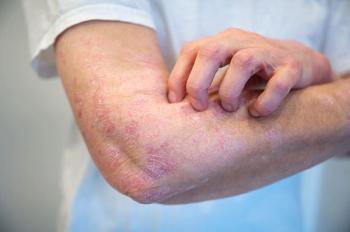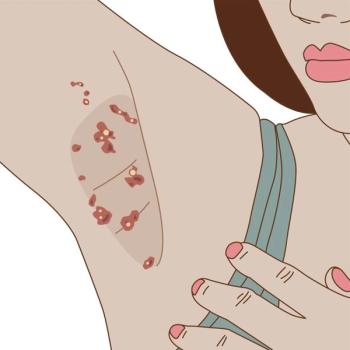
Case 4: Should this eruption prompt a search for other lesions?
For a few months, a 51-year-old woman has had an asymptomatic rash on her proximal thighs. She claims to have no other rashes and denies any exposure history.
For a few months, a 51-year-old woman has had an asymptomatic rash on her proximal thighs. She claims to have no other rashes and denies any exposure history.
What are you looking at here?
A. Tinea corporis.
B. Erythema multiforme.
C. Lichen planus.
D. Erythema annulare centrifugum.
E. Nummular eczema.
Bonus question: Is there any diagnostic procedure you would perform?
Double bonus question: What other part of the body would you check
and why?
Case 4: Erythema annulare centrifugum
Answer to bonus question: A potassium hydroxide examination was performed, and the results were positive.
Answer to double bonus question: The patient’s feet were also examined.
This patient had erythema annulare centrifugum (EAC), D, from her tinea pedis. EAC is a reactive process to an underlying disease, usually a dermatophyte infection.
Unlike this patient’s asymptomatic rash, tinea corporis is typically pruritic. Erythema multiforme generally does not feature as much scale as is seen here. Lichen planus is characterized by purple, flat-topped, polygonal papules that do not resemble this patient’s rash. The absence of pruritus and the lack of a history of atopy made nummular eczema unlikely.
In this patient, the tinea pedis was treated with both oral and topical antifungals, and the EAC resolved. One option for oral therapy is terbinafine, 250 mg/d for 1 week every 3 months for 1 year. The cure rate is 93%.1
References:
REFERENCE:
1.
Zaias N, Rebell G. The successful treatment of Trichophyton rubrum nail bed (distal subungual) onychomycosis with intermittent pulse-dosed terbinafine.
Arch Dermatol.
2004;140:691-695.
Newsletter
Enhance your clinical practice with the Patient Care newsletter, offering the latest evidence-based guidelines, diagnostic insights, and treatment strategies for primary care physicians.



























































































































































































































































































